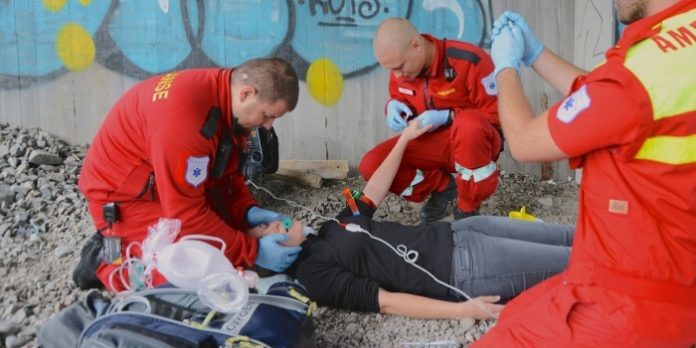
“Every year, drug overdoses are responsible for roughly 1000 ambulance calls in Oslo,” says Arne Skulberg, an anaesthesiologist, a PhD candidate at NTNU and the 2014 winner of Norway’s Researcher Grand Prix competition.
In response, along with Professor Ola Dale and Ida Tylleskär, from the Medical Students’ Research Programme (MSRP) at NTNU, Skulberg has developed a nasal spray to treat drug overdoses.
Next year, the nasal spray will be tested in 260 overdose cases in Oslo and Trondheim.
Drug addicts deserve new treatments
“More people in Norway die annually of drug overdoses than in traffic accidents,” says Skulberg, from NTNU’s Department of Circulation and Medical Imaging. “Drug addicts deserve new medications that are researched and regulated just like any other patient group.”
The researchers hope the nasal spray can be handed out to drug addicts, police officers, security guards and paramedics, so that more lives can be saved.
Breathing stops
“Many deaths from an overdose happen after the individual has stopped drug use for a while, such as when he or she has spent time in prison,” says Skulberg.
When too much heroin enters the body, the breathing centre in the brain is dulled. Breathing will slow or stop completely, and death occurs quickly if no breathing assistance or treatment is given.
Currently, paramedics treat overdoses with an injection, either as an intramuscular injection, or sometimes straight into the veins.
Anyone can help
“Not all drug addicts are able to give mouth-to-mouth resuscitation to their friends. Security guards, relatives and employees at homeless shelters don’t necessarily feel competent enough to administer injections or give mouth-to-mouth either,” Skulberg says. “With this nasal spray, anyone can easily give life-saving and effective help.”
In addition to his PhD studies, Skulberg works for the ambulance service in Oslo.
High risk of blood contamination
“People who need this kind of help are often found in alleys, behind containers, under bridges. It’s often dark and the work conditions are difficult,” Skulberg explains. “It would help a lot to not have give an injection under conditions like this. When an addict wakes up after an overdose, they may be upset or scared. If there’s a commotion, the paramedics may get stabbed by the needle that was used on the patient.”
“There’s a high risk of blood contamination for those who work with drug addicts,” says Dale. “With a nasal spray, there’s less blood spilled, which minimizes the risk of contamination.”
Tested on 17 medical students
The drug naloxone has been used for years to treat heroin overdoses, but it is commonly injected. It is this same drug that is being used in the nasal spray.
Finding the correct dosage has been difficult. The research team has tested the spray on 17 medical students and compared the results to injecting the drug intravenously.
The goal was to test how much of the drug was absorbed into the blood using these different methods. The medication only works if you actually have heroin or similar drugs in your system, so the only thing test subjects experienced was mild nasal discomfort. The results of these tests were quite promising.
Both injection and spray
When the nasal spray is tested on drug addicts, paramedics will have a package containing the spray and an injection, both of which will be used to treat the overdose. Only one of the methods actually contains medication. The study is blind, because precise criteria for which method is more effective are difficult to define.
When paramedics arrive at the scene of an overdose, the first procedure is to help with the person’s breathing. Then both the injection and nasal spray will be used, and the timer is started. They will time how long it takes before the patient takes their first breath on their own, when they can breathe evenly on their own, when their eyes open, and when they begin to move.
Right to proper help
“Drug addicts are often young people who potentially can live a good, long life until their last heartbeat. They have the right to the same care for their disease as everyone else does,” says Skulberg. “Many politicians are very preoccupied with all addicts getting clean. In the meantime, too many people die of overdoses. With this nasal spray, hopefully more addicts can survive and become clean.”
Story Source:
The above story is based on materials provided by The Norwegian University of Science and Technology (NTNU). Note: Materials may be edited for content and length.
